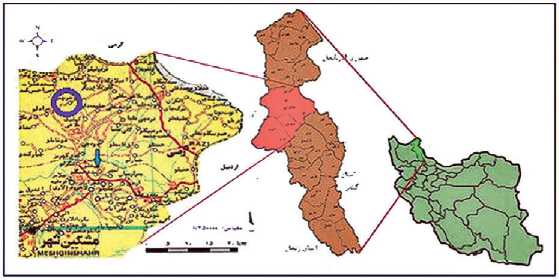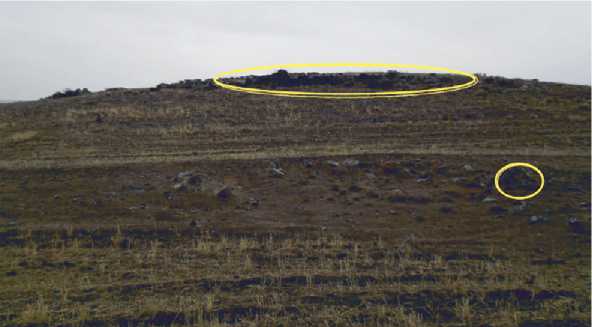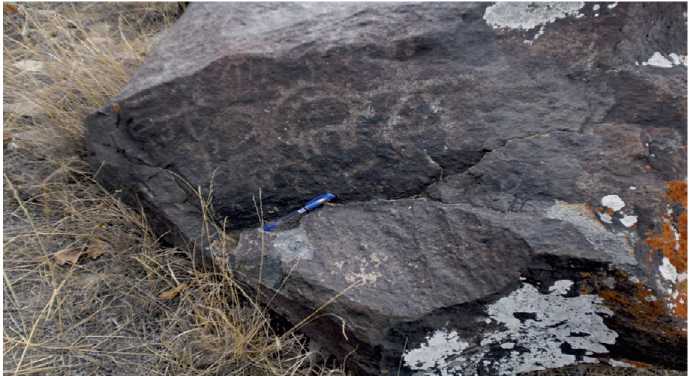Discovering New Rock Arts at Meshgin Shahr’s Ghafeleghatar, Northwest of Iran
Автор: S. Abdolahi, S. Sattarnejad, S. Parvin, M. Samari
Журнал: Краткие сообщения Института археологии @ksia-iaran
Рубрика: Археологические находки и изобразительные материалы
Статья в выпуске: 264, 2021 года.
Бесплатный доступ
The historical site of the Ghafeleghatar was discovered in 2018 during archaeological survey in the Ardabil province in the northwest of Iran. Totally 50 images including goat, deer, and human figures have been identified and documented in this area. These motifs are represented individually and in compositions placed on black magnetite stones by scratching and striking technique. Most of the images show goat, which is comparable to many specimen from Iran and Azerbaijan. The images illustrate the nomadic and hunting-gathering nature of the designers of these works. The periods of formation of the images are unclear, so that no reliable dating and clear chronology can be suggested based on comparative studies.
Iran, Meshgin Shahr, Ghafeleghatar, rock art
Короткий адрес: https://sciup.org/143176913
IDR: 143176913 | DOI: 10.25681/IARAS.0130-2620.264.222-228
Текст научной статьи Discovering New Rock Arts at Meshgin Shahr’s Ghafeleghatar, Northwest of Iran
Rock art is one of the most prominent examples of art and culture works that are important documents in various fields of science, including archeology, art history, and social sciences. As yet a considerable number of these works have been discovered and introduced in different parts of the world. Rock art is also widely distributed in Iran and so far a considerable number of these works have been reported from different parts of Iran: Gazu in Balochistan (Dessau, 1960), Mirmalas in Lorestan (Bourne, 1969. P. 16), Ashkaftahoo in Bushehr (Asadi, 2007. P. 70), Teimareh (near Golpayegan City) (Farhadi, 1998. P. 65), Hurand in Ahar city, Dozdedaghi (Kazem-pur et al., 2011), Shahar Yeri in Meshgin Shahr (Horshid, 2004), Mahabad (Mohammadi Qasrian, 2007), Sheikh Madi in Meshgin Shahr (Kazemi et al., 2016), North Khorasan (Vahdati, 2010). The mentioned sites contain rock art motifs such as animal, human, geometric patterns that continued from the Palaeolithic to the Sassanid period in terms of chronology (Azandaryani et al., 2015. P. 62). Archaeological excavations http://doi.org/10.25681/IARAS.0130-2620.264.222-228
in the Moradlo area in Meshgin Shahr were carried out by the authors in the fall of 2018 whereupon many archaeological sites have been discovered including the Ghafeleghatar motifs performed on the rocks.
The historical site of Ghafeleghatar
The rock images of the Charchaman’ Ghafeleghatar are located in the mountainous area of Meshgin Shahr in the northwest of Iran. This rock art site is located 300 m to the southeast from Charchaman village, Moradlo district of Meshgin Shahr (Fig. 1). The petroglyphs are located at an altitude of 1300 m above the sea level with the geographical coordinates 38°44’53.72” N, 47°44’40.02” E.

Fig. 1. Location of rock art sites in Ardabil province
The area provides good conditions for pastoral activities for a long time, the main occupation of the people in the area was herding, especially goat and sheep breeding. In 2018 investigation and identification of the Charchaman petroglyphs were performed. The rock motifs of the Ghafeleghatar are made on black iron-colored rocks located on the slope terrace overlooking the old road known as El yoli. The images form a relatively large complex on the stack of the black rocks about 100 m long in the north-south direction and about 700 m wide in the east-west direction (Fig. 2). Some images are not visible on the rocks due to erosion and downfall. In general, the images include animal and human motifs, the images determined as goat (ibex) are most numerous. So far, a total of 50 images have been identified, including human motifs (5 images), ibex (40 images) and deer (5 images) respectively. Most of the images were made with repeated striking on the rock surface and in some cases with scratching the stone. The images are of different size, their contours vary in depth from 1 mm to 3 mm from the surface of the stone. The contours of some images are filled in due to the influence of natural factors in the course of time, so that they are almost on the same level with the rock. Some images are very close to the rock background and are not easily visible.

Fig. 2. View of Ghafeleghatar locality
Motifs of ibex
The motifs of ibex on the rocks are very varied morphologically, this diversity is evident in representation of the horns that are not proportionate to the animal’s body. The long, semi-circular horns are shown turned backward and disproportionally extended to the tail of the animal (Fig. 3). In general, the motif of goat in the rock art of Iran occupies the largest number and points that this animal played an important role in the domestic economy in the early period of Iranian society. Today, in the Moradlo area of Meshgin Shahr, livestock families mainly keep goats and sheep, which indicates that in the past ibex and sheep also reached a high percentage in herds and natural environment.

Fig. 3. The images of goats with long horns
Human motifs
Among the Charchaman petroglyphs limited number of human images are registered, these motifs are in minority as compared to the number of animal images. Only five human figures have been identified and recorded among the petroglyphs. In general, the human images of this series are shown full-face. The figures are very simple in shape and highly stylized, shown with minimal outlines, their volume not displayed (Fig. 4). Human images are presented in compositions alongside with animal motifs, which indicates some everyday relationship between humans and animals.

Fig. 4. The human image in the herd of ibex
The motif of deer
Another example of animal motifs in the Ghafeleghatar petroglyphs is the image of a deer. The animal is shown in profile with relatively long neck and short horns. These motifs, like ibex images, are performed in abstract manner and exhibit anatomical forms of the body. No attempt can be seen to present the body details, or create an effect of depth and volume in the drawings (Fig. 5). Interestingly, presence of the motif of deer in the environment of the Azerbaijani region in the past indicates that this animal was hunted and thus played an important role in everyday life of people in the region.

Fig. 5. Composition with a deer alongside with other motifs
Conclusions
It should be stated that a limited number of rock images have been identified in Ardebil province in northwestern Iran. It seems very important to study and introduce the Ghafeleghatar rock images that comprise a variety of human and animal motifs. Totally 50 images were identified during the study of this area. The collection includes images of ibex, deer, and humans shown individually or in groups. These motifs can be of interest for some areas of anthropological and sociological concepts of nomadic and hunting-gathering lifestyle, taking into account that goat images represent an economy based on animal husbandry and nomadic activities, while motif of deer indicates hunting practiced in this community. Some scholars in Iran ascribe the period of creation of these drawings, especially the goat images to the prehistoric period, but due to the lack of laboratory studies in Iran it is not possible at present to determine the age of this rock art site, so that no reliable chronology can be suggested for these works so far.
Список литературы Discovering New Rock Arts at Meshgin Shahr’s Ghafeleghatar, Northwest of Iran
- Asadi A., 2007. Eshkaft-e Ahoo: Panahgahisakhe-e edar Bastak (Hormozgan) // Bastanpazhohi. 3. P. 65–70.
- Azandaryani E. H., Qolami H., Mohammadi Far Y., Razmposh A., 2015. Discovering New Rock Paintings at Shаmsali and Gorgali Rock Shelters in Kohgiluye and Bouier Ahmad Province, Southern Iran // Arts. Vol. 4. No. 2. P. 61–67.
- Bourne M., 1969. Preliminary Report on the review and excavation in the Kuhdasht Area caves / Trans. by Z. Rahmatian // Iranian Archeology and Art. No. 3. P. 14–16.
- Dessau G., 1960. Rock Engravings (Graffiti) from Iranian Bäluchistan // East and West. Vol. 11. No. 1. P. 258–266.
- Farhadi M., 1998. «Museums in the wind». Tehran: Allameh Tabataba’i University. P. 65–67. (In Persian.)
- Horshid S. H., 2004. Petroglyphs of Pirazmian // Proceedings of the international symposium on the Iranian archaeology: northwestern region / Ed. M. Azarnoush. Tehran: Iranian center for archaeological research. P. 123–131. (In Persian.)
- Kazemi M., Naseri H. S., Hemati E. A., Mirzaei M., 2016. An Introduction of Shikh Medi Newly Found Petroglyphs in Meshginshahr, Northwest Iran // International Journal of Archaeology. Vol. 4. Iss. 2/1. P. 18–22.
- Kazempur M., Eskandari N., Shafizade A., 2011. The lithograph of Dowzdaghi, Northwestern Iran // Documenta Praehistorica. Vol. XXXVIII. P. 383–387.
- Mohammadi Qasrian S., 2007. A study of petroglyphs in Iran: problems and solutions // Bastanshen Pazhuhi. 2–3. P. 15–18. (In Persian.)
- Vahdati A. A., 2010. Stone Canvases: A Preliminary Report on the Study of Two Rock-Art Complexes in North Khorasan Province, Northeastern Iran. Khora-san-e-Shomali: I.C.H.T.O Publishing. 121 p.


